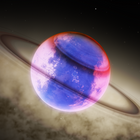|
SpaceEngine Planet Classifications
|
|
| AiioFlux | Date: Friday, 25.07.2014, 22:04 | Message # 196 |
 Space Tourist
Group: Users
 United Kingdom
United Kingdom
Messages: 32
Status: Offline
| Quote Exognosis (  ) Frigid
That definitely makes more sense
You are now breathing manually..
|
| |
| |
| RockoRocks | Date: Saturday, 26.07.2014, 08:01 | Message # 197 |
 World Builder
Group: Users
 Belgium
Belgium
Messages: 674
Status: Offline
| Yes, it should definetely be frigid, I don't know any better word
I will be inactive on this forum for the time being. Might come back eventually
AMD AR-3305M APU w/ Radeon HD 1.90 GHz 6,00 GB RAM
|
| |
| |
| Jadestar | Date: Saturday, 02.08.2014, 20:45 | Message # 198 |
|
Astronaut
Group: Users
 United States
United States
Messages: 70
Status: Offline
| Quote Tzion (  ) I'd like to suggest replacing the "Comfort" temperature label with "Temperate". "Comfort" seems to suggest more attributes than just a habitable temperature range.
I second this. Temperate Terra is actually used a lot by exo-planetologists.
Quote DevonX (  )
I don't think a letter system is appropriate in SE for the above reason,
it was more aimed at realism, then it'd probably be closer to what planetologists
will eventually come up with.
There is a system some exo-planetologists are now using.
From the Planetary Habitability Lab at the University of Puerto Rico Arecibo....
Planetary Class (pClass)

The pClass classifies planetary bodies with a combination of three thermal zones and seven mass categories. The thermal zones are hot, warm, and cold. They are related to the orbital position of the body with respect to the HZ, warm being the HZ. The mass divisions are asteroidan, mercurian, subterran, terran, superterran, neptunian, and jovian. The classification can be used for any solar and extrasolar planets including moons.
And....
Habitable Class (hClass)


The hClass is a classification only for habitable worlds (terrestrial planets inside the HZ) in five thermal categories. The categories are hypopsychroplanets (Class hP), psychroplanets (Class P), mesoplanets (Class M), thermoplanets (Class T), and hyperthermoplanets (Class hT). These names where inspired by the names used in microbiology to describe the growth temperatures of microbial life. Class M planets also have the thermal surface requirements to support complex life (0-50°C), a name familiar from science fiction. The other categories represent conditions only habitable by extremophilic life. The generic Class NH is used for non habitable planets.
Quote Neon (  ) I think I might do a back flip and change my mind on the naming system
of planets. Really, we use a the accepted letter system for star classification,
why not use the same system for planets. Anyone into a space program like
this is probably going to want to know it.
I agree 100%!!!  
It's clear there is a movement towards a letter system for exo-planet classification. It would be very cool if SE incorporated what is already out there in the exoplanet community at least with regards to rocky worlds.
Edited by Jadestar - Saturday, 02.08.2014, 20:47 |
| |
| |
| Salvo | Date: Sunday, 03.08.2014, 11:47 | Message # 199 |
 Star Engineer
Group: Local Moderators
 Italy
Italy
Messages: 1400
Status: Offline
| I agree for Thermal Classification, in addition to normal classification, but I don't think words like "Mercurian" "Jovian" or "Neptunian" for exoplanets fits very well in SE 
The universe is not required to be in perfect harmony with human ambition.
CPU: Intel Core i7 4770 GPU: ASUS Radeon R9 270 RAM: 8 GBs
(still don't know why everyone is doing this...)
Edited by Salvo - Sunday, 03.08.2014, 11:48 |
| |
| |
| SpaceEngineer | Date: Saturday, 16.08.2014, 22:36 | Message # 200 |
 Author of Space Engine
Group: Administrators
 Russian Federation
Russian Federation
Messages: 4800
Status: Offline
| Returning back to planet classification. Now we ended up with a system discussed on a page 11. It is based on several classnames describing some properties of a planet, grouped in a few lines described planet itself, its surface, ocean and atmosphere. Here I describe possible alternative sets of classnames.
Planet body
Size classes:
subterran - terran - superterran - subjovian - jovian - superjovian
subearth - earth - superearth - neptune - jupiter - superjupiter
selena - subterra - terra - superterra - subgiant - giant - supergiant
subselena - selena - superselena - subterra - terra - superterra - subgiant - giant - supergiant
dwarf - subterra - terra - superterra - ice giant - gas giant - supergiant
Temperature classes:
scorched - hot - warm - temperate - cool - cold - frozen
scorched - hot - warm - temperate - cool - cold - cryogenic
hot - warm - temperate - cool - cold (less class names, but reserve "hot" for hot planet like hot jupiters)
Additional info:
with life - tidal locked - lava - rocky - oceanic - icy
inhabitated - synchronized - volcanic - rocky - oceanic - icy
Surface
Surface composition classes:
lava - rocks - ice - water - hydrocarbons
lava - rocky - carbonic - icy - oceanic (global ocean)
Ocean
Ocean coverage classes:
arid - laky - marine - oceanic
arid - semiarid - marine - oceanic - global
desert - lakes - seas - oceans - global ocean
Ocean composition classes:
water - hydrocarbones - ammonia - nitrogen - neon
water - organic - ammonia - nitrogen - neon
water - methane - ammonia - nitrogen - neon
Additional info:
subsurface
Atmosphere
Pressure classes:
airless - hypobaric - mesobaryc - hyperbaric
airless - thin - normal - dense
airless - thin - normal - dense - crushed
Breathability:
breathable - unbreathable - toxic
Additional info:
corrosion
Examples. In [ ] are alternative words.
Planet Mercury
Class: warm rocky subterran [subterra, superselena]
Surface: rocks, ice
Ocean: no
Atmosphere: airless [no]
Planet Venus
Class: hot rocky terran [terra]
Surface: rocks
Ocean: no
Atmosphere: hyperbaric [crushed], toxic, corrosion
Planet Earth
Class: temperate rocky terran [terra] with life [inhabited]
Surface: rocks, water, ice
Ocean: water seas
Atmosphere: mesobaric [normal], breathable
Planet Mars
Class: cool rocky subterran [subterra]
Surface: rocks, ice
Ocean: no
Atmosphere: hypobaric [thin], unbreathable
Planet Jupiter, Saturn
Class: cold jovian [jupiter, gas giant]
(Surface, Ocean, Atmosphere may be missed in description)
Planet Uranus, Neptune
Class: cold subjovian [neptune, ice giant]
(Surface, Ocean, Atmosphere may be missed in description)
Dwarf Planet Ceres
Class: cool icy subterran [dwarf, subselena]
Surface: rocks, ice
Ocean: no
Atmosphere: airless [no]
Dwarf Planet Pluto
Class: frozen ice subterran [dwarf, subselena]
Surface: ice
Ocean: nitrogen (as example)
Atmosphere: hypobaric, unbreathable
Moon Moon
Class: temperate subterran [subterra, selena]
Surface: rocks, ice
Ocean: no
Atmosphere: airless [no]
Moon Io
Class: cold volcanic subterran [subterra, selena]
Surface: rocks
Ocean: no
Atmosphere: airless [no]
Moon Europa
Class: cold icy subterran [subterra, selena] with life
Surface: ice
Ocean: subsurface water global ocean
Atmosphere: airless [no]
Moon Ganymede, Callisto
Class: cold icy subterran [subterra, superselena]
Surface: rocks, ice
Ocean: subsurface water global ocean
Atmosphere: airless [no]
Moon Titan
Class: cold icy subterran [subterra, superselena]
Surface: rocks, methane
Ocean: methane lakes, subsurface water global ocean
Atmosphere: mesobaric [normal], toxic
Planet Gliese 1214 b
Class: warm oceaninc superterran [superterra]
Surface: global ocean
Ocean: water global ocean
Atmosphere: hyperbaric [dense], unbreathable
Planet CoRoT-7b
Class: scorched lava superterran [superterra]
Surface: rocks, lava
Ocean: lava seas
Atmosphere: hyperbaric [dense], toxic
|
| |
| |
| DoctorOfSpace | Date: Sunday, 17.08.2014, 00:57 | Message # 201 |
 Galaxy Architect
Group: Global Moderators
 Pirate
Pirate
Messages: 3600
Status: Offline
| Quote SpaceEngineer (  ) arid - semiarid - marine - oceanic - global
This could be something like
arid, semi-arid, humid, and oceanic.
Perhaps this could be of some use when doing climates
http://en.wikipedia.org/wiki/K%C3%B6ppen_climate_classification
Intel Core i7-5820K 4.2GHz 6-Core Processor
G.Skill Ripjaws V Series 32GB (4 x 8GB) DDR4-2400 Memory
EVGA GTX 980 Ti SC 6GB
|
| |
| |
| AiioFlux | Date: Sunday, 17.08.2014, 01:03 | Message # 202 |
 Space Tourist
Group: Users
 United Kingdom
United Kingdom
Messages: 32
Status: Offline
| This looks much more comprehensive. I just can't wait to fly around the more diverse universe with all of these! (Sorry this isn't a very useful comment, I just love space engine)
You are now breathing manually..
|
| |
| |
| FastFourierTransform | Date: Sunday, 17.08.2014, 13:26 | Message # 203 |
 Pioneer
Group: Local Moderators
 Spain
Spain
Messages: 542
Status: Offline
| Quote SpaceEngineer (  ) dwarf - subterra - terra - superterra - ice giant - gas giant - supergiant
Thats definetly the most accurate classification of size.
By the way, this is only for displaying information? or this is also the classification of different types of planets that the engine would render? because if is the second case I think this need more planet variations to generate.
|
| |
| |
| Tac1017 | Date: Sunday, 17.08.2014, 15:16 | Message # 204 |
 Explorer
Group: Users
 United States
United States
Messages: 167
Status: Offline
| I was thinking of calling Ice Giants Gas dwarfs...
The Terra Hunter of the Milky Way!
(By the way, I was born in 2001, NOT 1972 XD)
|
| |
| |
| SpaceEngineer | Date: Sunday, 17.08.2014, 15:40 | Message # 205 |
 Author of Space Engine
Group: Administrators
 Russian Federation
Russian Federation
Messages: 4800
Status: Offline
| Quote FastFourierTransform (  ) By the way, this is only for displaying information? or this is also the classification of different types of planets that the engine would render? because if is the second case I think this need more planet variations to generate.
No. This system will be implemented with the new star system generator. It will model formation and evolution of the system, operating balls of various materials (iron, rocks, water, hydrogen etc). After complete, it will calculate surface composition, atmosphere composition, climate and trying to classify the final body. Unlike current generator, which generates planet class first (ie terra, desert, ice giant etc), and then trying to compute its surface appearance.

|
| |
| |
| RockoRocks | Date: Sunday, 17.08.2014, 16:11 | Message # 206 |
 World Builder
Group: Users
 Belgium
Belgium
Messages: 674
Status: Offline
| Quote Tac1017 (  ) I was thinking of calling Ice Giants Gas dwarfs...
This would not make sense because Ice Giants are not neccesarily smaller than Gas Giants. The name 'Gas dwarf' would imply otherwise.
I will be inactive on this forum for the time being. Might come back eventually
AMD AR-3305M APU w/ Radeon HD 1.90 GHz 6,00 GB RAM
|
| |
| |
| DeathStar | Date: Sunday, 17.08.2014, 19:51 | Message # 207 |
|
Pioneer
Group: Users
 Croatia
Croatia
Messages: 515
Status: Offline
| Quote SpaceEngineer (  ) No. This system will be implemented with the new star system generator. It will model formation and evolution of the system, operating balls of various materials (iron, rocks, water, hydrogen etc). After complete, it will calculate surface composition, atmosphere composition, climate and trying to classify the final body. Unlike current generator, which generates planet class first (ie terra, desert, ice giant etc), and then trying to compute its surface appearance.
How in-depth would these simulations actually be? Would it also simulate gravitational interactions during the evolution of the system, i.e. there will be planetoids in orbital resonances with large gas giants, not because the generator just said so, but because it was the result of the simulation of the evolution of the system? I am assuming this will be in.
Will it take into account the collisions between bodies during simulation? For example, a large crater on the surface of a planet be due to an actual collision with an asteroid during the simulation. Or will a moon around a rocky planet be the result of an impact of another large body during the early history of the planet(Giant impact hypothesis)? I am also assuming this will be taken into account.
|
| |
| |
| Inarius | Date: Sunday, 17.08.2014, 21:28 | Message # 208 |
 Explorer
Group: Local Moderators
 France
France
Messages: 237
Status: Offline
| What about Encelade or Mars ? Life on Europe is not 100% sure, (or do I missed something ?)
The classification for planets seems fine, what about comets, or meteorites ? Sometimes the difference between some dwarf planets (such as Ceres) and biggest meteorites is not very clear...
|
| |
| |
| NickWaterfall | Date: Tuesday, 02.09.2014, 15:00 | Message # 209 |
|
Space Tourist
Group: Users
 Norway
Norway
Messages: 23
Status: Offline
| Quote RockoRocks (  ) This would not make sense because Ice Giants are not neccesarily smaller than Gas Giants. The name 'Gas dwarf' would imply otherwise.
The largest ice giant in SE is smaller than the smallest gas giant in SE.
|
| |
| |
| FastFourierTransform | Date: Tuesday, 02.09.2014, 16:06 | Message # 210 |
 Pioneer
Group: Local Moderators
 Spain
Spain
Messages: 542
Status: Offline
| Quote SpaceEngineer (  ) This system will be implemented with the new star system generator.
Quote SpaceEngineer (  ) Unlike current generator, which generates planet class first (ie terra, desert, ice giant etc), and then trying to compute its surface appearance.
Wow!, that will be amazing (if you manage to perform all those beautifull surfaces and color palettes we have now inside the new context)
|
| |
| |